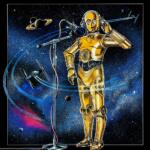Prejudice of the Melodic
- Dette emnet har 42 svar, 6 deltakere, og ble sist oppdatert 3 dager, 23 timer siden av
 Thor Joachim Haga.
Thor Joachim Haga.
-
ForfatterInnlegg
-
7. August 2025 klokken 13:37 #5350
 Nick ZwarDeltaker
Nick ZwarDeltakerI don’t remember any music that I enjoyed that I then some point later didn’t enjoy anymore. As I said, there was a lot of music that I discovered along the way or learned to like, but never the other way around, I never stopped liking something I once liked.
If I think back, some of the earliest pieces of music that I loved as a child, were Beethoven’s 5th Symphony, Mozart’s Magic Flute (parts of it), Prokofiev’s Peter and the Wolf, Smetanas The Moldau, Ravel’s Bolero, the Pink Panther theme, and TV themes such as PETROCELLI, THE WALTONS, THE MAGICIAN, THE STREETS OF SAN FRANCISCO.
When I was in second grade, I used to watch the short lived TV series THE COWBOYS, which was based on the John Wayne movie with the same title, and I loved and whistled the main theme for that show. The show used John Williams’ theme from movie (of course, I did not know that back then), so this may have been my earliest encounter with the music of John Williams.
So I already enjoyed John Williams, Lalo Schifrin, and Jerry Goldsmith long before I ever knew their names, or knew one day I would collect their music on LPs and CDs. But I never stopped liking these earliest of favorites. 🙂7. August 2025 klokken 14:03 #5351 Malte MüllerNøkkelmester
Malte MüllerNøkkelmesterBut you, Malte and Nick, seem to have had a quite safe and constantly progressing journey through the wild oceans of music to have never experiecned anything, that made you revise your one or other oppinion on any musical piece.
Not revise I wouldn’t say. The general view on some scores sometimes can change of course, too. But it never got so far that I don’t like them anymore. I even more get to like thungs I didn’t previously, sort of re-discovering.
Like Nick TV themes had a huge impact, especially the groovy 70s/80s stuff, although we over here were a few years behind always (Mike Post specifially was all over the place. Someome should convince him to get a bit active with releasing…).
7. August 2025 klokken 14:53 #5352 Nick ZwarDeltaker
Nick ZwarDeltakerLalo Schifrin was among the first film composers I knew by name, simply because he had written a lot of main themes for TV back in the day when I grew up. So the end credits stated “theme music by Lalo Schifrin”, or something like that… for Petrocelli, Starsky & Hutch, Mission Impossible, probably some other stuff, when you watch some of that, episode after episode, even as a pre-teen child, you notice that the same name is on all of these shows with cool title themes.
7. August 2025 klokken 17:13 #5353 Malte MüllerNøkkelmester
Malte MüllerNøkkelmesterFor me it was Mike Post I knew by name early. Or from Bond specifially John Barry. I think Williams was the first other composer I really knew – if you don’t count Faltermeyer when “Axel F.” was a hit single ;-), Goldsmith came later for sure.
And over here they often edited tv series. Season had long delays, often the same intro although each season had different ones or similar (Magnum for example, here they even cut all Vietnam refrences in the original broadcast!)
7. August 2025 klokken 18:38 #5354 Thor Joachim HagaNøkkelmester
Thor Joachim HagaNøkkelmesterWhen you guys talk about the (excellent) Martinez score for SOLARIS, let’s not forget the even more excellent Artemiev score for the original Tarkovsky film. Also very much based on texture, although the variations of the Bach theme is obviously the most famous. I would consider both of these classics in their own way.
7. August 2025 klokken 21:45 #5356 Nils Jacob Holt HanssenDeltaker
Nils Jacob Holt HanssenDeltakerI don’t remember any music that I enjoyed that I then some point later didn’t enjoy anymore. As I said, there was a lot of music that I discovered along the way or learned to like, but never the other way around, I never stopped liking something I once liked.
It’s the same for me, actually. I can’t think of any music I’ve liked earlier that I don’t enjoy any longer – only the other way around. So while I said earlier that one’s musical tastes “change” and “develop”, I agree that “broaden”, which you used, is a better term.
7. August 2025 klokken 21:56 #5357 Nils Jacob Holt HanssenDeltaker
Nils Jacob Holt HanssenDeltakerWhen you guys talk about the (excellent) Martinez score for SOLARIS, let’s not forget the even more excellent Artemiev score for the original Tarkovsky film. Also very much based on texture, although the variations of the Bach theme is obviously the most famous. I would consider both of these classics in their own way.
I’ve never listened to Artemiev’s score outside of the film, but you’ve made me want to give it a try :). Is it on Spotify? There’s an album there that seems to be “SOLARIS by Eduard Artemyev” (the title is in Russian/Ciryllic letters), but it sounds like a modern synth version (?). Also, it’s 76 minutes long, so it’s doubtful it’s an original OST album from back in the day..
7. August 2025 klokken 22:01 #5358 Thor Joachim HagaNøkkelmester
Thor Joachim HagaNøkkelmesterI’ve never listened to Artemiev’s score outside of the film, but you’ve made me want to give it a try :). Is it on Spotify? There’s an album there that seems to be “SOLARIS by Eduard Artemyev” (the title is in Russian/Ciryllic letters), but it sounds like a modern synth version (?). Also, it’s 76 minutes long, so it’s doubtful it’s an original OST album from back in the day..
Try the great SOLARIS/STALKER/MIRROR album, showcasing three of his greatest scores for Tarkovsky. That album was my gateway drug into Artemiev, anyway, and features a good selection from SOLARIS. I can’t seem to find it on Spotify, but it’s on YouTube in its entirety.
7. August 2025 klokken 23:48 #5360 Nils Jacob Holt HanssenDeltaker
Nils Jacob Holt HanssenDeltakerTry the great SOLARIS/STALKER/MIRROR album, showcasing three of his greatest scores for Tarkovsky. That album was my gateway drug into Artemiev, anyway, and features a good selection from SOLARIS. I can’t seem to find it on Spotify, but it’s on YouTube in its entirety.
Thanks! 👍
19. November 2025 klokken 10:05 #6668 Thor Joachim HagaNøkkelmester
Thor Joachim HagaNøkkelmesterRami Nakhleh’s STRANGER (2024) — now here’s a good example of a score that is almost exclusively textural, but with INTERESTING, engrossing textures connoting foggy, earthy landscapes. Those nervous string instrument pluckings, the eerie use of reverb, some form of glass harmonica? Deep sense of melancholy. Doesn’t need any pronounced melody to function. Just totally hypnotizing as an album (I’ve not seen the film).
19. November 2025 klokken 12:37 #6669 SchilkemanDeltaker
SchilkemanDeltakerI think it’s important to distinguish between texture and timbre. As Copland describes in What to Listen for in Music, texture is more what we would call polyphony, homophony, or monophony, depending. Timbre is the use of instrumental color for effect. His main elements of music are rhythm, harmony, timbre, texture, form, and yes, melody. I feel bad for people who only listen for melodies. Interesting music comes form knowing when and how to use all the elements.
19. November 2025 klokken 14:47 #6671 GerateWohlDeltaker
GerateWohlDeltakerI think it’s important to distinguish between texture and timbre. As Copland describes in What to Listen for in Music, texture is more what we would call polyphony, homophony, or monophony, depending. Timbre is the use of instrumental color for effect. His main elements of music are rhythm, harmony, timbre, texture, form, and yes, melody. I feel bad for people who only listen for melodies. Interesting music comes form knowing when and how to use all the elements.
I agree 100%. What annoys me at a lot of modern soundtracks that most younger composers (but also older ones like Hans Zimmer, Chris Young or Alex Desplat, but also Michael Giacchino) are using ostinati like some kind of loop in techno. That often makes their melodies sound very monotone. And ostinato shouldn’t be an end in itself but support or counterpoint the melody. So, as the melody, evolves the counterpoint should, too.
I agree, that sometimes such a monotone ostinato can generate a nice effect. But in the meantime this seems to have become the basic architecture of most orchestral film scores.
For purely textural scores it is something different. I grt that. But if I use melody, I should write an appropriate accompaniment.
Unless I do pop or techno. But then I don’t need an orchestra.
19. November 2025 klokken 18:42 #6672 Thor Joachim HagaNøkkelmester
Thor Joachim HagaNøkkelmesterI think it’s important to distinguish between texture and timbre. As Copland describes in What to Listen for in Music, texture is more what we would call polyphony, homophony, or monophony, depending. Timbre is the use of instrumental color for effect. His main elements of music are rhythm, harmony, timbre, texture, form, and yes, melody. I feel bad for people who only listen for melodies. Interesting music comes form knowing when and how to use all the elements.
Yes, you’re no doubt right about the difference between texture and timbre, Schilke, but texture is kinda used in colloquial speech as these layered sounds. In my (now ancient) thesis, I used Leonard B. Meyer’s definition in his iconic book Emotion and Meaning in Music (1956):
“Texture has to do with the ways in which the mind groups concurrent musical stimuli into simultaneous figures /…/ a distribution of texture is not necessarily apprehended in terms of a figure-ground distribution but can quite readily be perceived as the co-existence of several, independent, well-articulated figures” (Meyer 1956: 185)
Less specific, but general enough to serve my purpose in that context.
-
ForfatterInnlegg
- Du må være innlogget for å svare på dette emnet.
